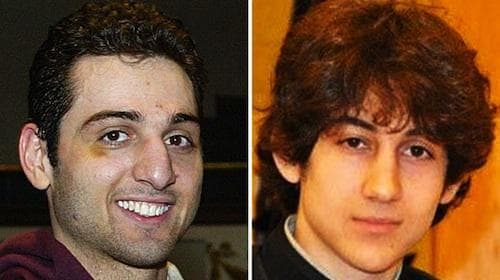Advertisement
Could Boxing Brain Damage Have Triggered Tsarnaev?

Historical note: The name of the older Tsarnaev brother, Tamerlan, comes from the medieval Central Asian conqueror Tammerlane, also known as Timur the Terrible, who called himself "The Sword of Islam."
And Tamerlan Tsarnaev, the deceased marathon bombing suspect, fashioned himself into a modern version of a warrior — as a boxer. But in modern times, we're also increasingly aware that repeated blows to the brain, in boxing or other athletic combat, can cause serious damage known as Chronic Traumatic Encephalopathy, or CTE — and that in some people, that brain damage has been linked to violence unsanctioned by sports.
Might such brain damage have helped turn Tamerlan Tsarnaev into a terrorist? Sunday's Boston Globe featured a call from two leading experts on CTE — Boston University's Dr. Robert Cantu and Dr. Robert Stern — for a special autopsy on Tamerlan Tsarnaev's brain to examine it for boxing damage. They also expressed "serious doubt" that such damage was to blame.
The early symptoms can include personality change, impulsivity, explosiveness, a short fuse, rage and aggression.
But as we all puzzle over what could have triggered the marathon attack, I pressed Dr. Stern, a professor of neurology and neurosurgery at the Boston University School of Medicine and co-founder of the university's Center for the Study of Traumatic Encephalopathy: What do we know about the connection between sports-related brain damage and violence? Tamerlan Tsarnaev had incurred a charge of domestic violence; that reminded me of NFL linebacker Junior Seau, who was also accused of domestic violence before he committed suicide last year, and was later found to have CTE.

Dr. Stern: "In boxers, what we know from 80 years of case reports — and I say 80 years because the first article came out in the Journal of the American Medical Association in 1928, and ever since there's been a lot of focus on boxers and being "punchdrunk," or dementia pugilistica, which is the same as Chronic Traumatic Encephalopathy — what we glean from all of that, plus my own research at BU, is that the early symptoms of CTE can include personality change, impulsivity, explosiveness, a short fuse, rage and aggression.
So these things happen. They happen frequently, they're a major part of CTE, this brain disease that doesn't affect everyone who hits their heads over and over again, but when the disease is there, those are some of the early symptoms, especially in boxers. That is the connection.
Where it falls apart is when there is a well-thought-out, highly planned act where it's not an impulsive, out-of-control, short-fuse rage.
But where it falls apart is when there is a well-thought-out, highly planned act where it's not an impulsive, out-of-control, short-fuse rage. So that's the big distinction. There are very disturbed people out there who are terrorists and who do awful things and who plan things way in advance and have training and all that — that's not a symptom of CTE."
My final push: But mightn't CTE have created an emotional substrate — of anger — for involvement in planned terror?
You can go there if you want, Dr. Stern said. But "the type of behavior and changes we're talking about are among the most complex and multi-faceted behaviors there can be in human existence. And there can't be a single reason or cause for one individual's behavior."
Readers, reactions? Theories? Personally, I'd rather believe in brain damage than evil...
This program aired on April 24, 2013. The audio for this program is not available.
